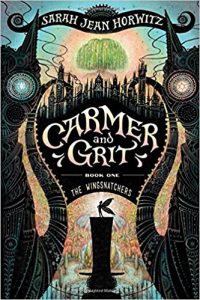Gary K. Wolfe Reviews Black Leopard, Red Wolf by Marlon James
 Black Leopard, Red Wolf, Marlon James (Riverhead 978-0-7352-2017-1, $30.00, 640pp, hc) February 2019.
Black Leopard, Red Wolf, Marlon James (Riverhead 978-0-7352-2017-1, $30.00, 640pp, hc) February 2019.
Novelists who approach genre materials after having been more or less certified as “literary” writers tend to start by revisiting fairly familiar territory – zombie apocalypses (Colson Whitehead), vampires (Justin Cronin), drizzly dystopias (just about everyone else). Marlon James, with his Man Booker Prize for A Brief History of Seven Killings and several other prominent nominations, arrives with about as many mainstream decals as you can get, but chooses a radically different path. With Black Leopard, Red Wolf, the first volume in his projected Dark Star trilogy, he seems intent on exploring not what epic fantasy has accomplished, but what it has largely ignored. There are, to be sure, moments of extreme violence and treacherous conniving, and a tendency to let characters get maimed or killed that will remind some of George R.R. Martin, and there’s a sort of quest through various colorful settings while facing awesome supernatural antagonists that recall the Tolkien tradition, but almost any direct comparisons are going to be misleading, and there are just as many echoes of African writers like Amos Tutuola or Daniel O. Fagunwa (whose Forest of a Thousand Demons, supposedly the first Yoruba-language novel, could almost serve as a subtitle for parts of James’s novel). Instead of a faux-medieval Europe with echoes of familiar legends, he sets his tale in a faux-medieval Africa with far less widely familiar echoes of sub-Saharan myths and legends (as with Nnedi Okorafor, it’s sometimes tricky to distinguish between what’s borrowed and what’s invented). His basic plot template is less that of the heroic quest than that of an extremely hardboiled detective on a missing persons case.
The detective (more or less) and the main narrator is known only as Tracker, who has forgotten the name given him by his abusive father, whom he may have killed. Tracker’s unique gift is the ability to follow people by scent, even if they are miles away, and, in one case, in the land of the dead. He begins his tale, apparently testifying before some sort of grand inquisitor, by offering bits of his résumé: his adventures after leaving his father’s house, meeting a man claiming to be his uncle (who tells him that he is now too old to be circumcised and thus will “be both man and woman”), and most importantly, meeting the shape-changing leopard man who will be his redoubtable companion for most of the novel. The leopard tries unsuccessfully to teach Tracker how to shoot a bow (though he later proves to be a pretty adept hatchet-slinger), and the two of them work together to save a group of “mingi” – children normally killed at birth because of deformities that can be as simple as having upper teeth come in first and as exceptional as conjoined twins, a girl made of blue smoke, a legless boy in the form of a sphere, and another boy with “legs as long as a giraffe.” After working with Tracker on various assignments which take them to the capital city of the North (and after we pick up various clues about ongoing tensions between this northern kingdom and the “mad kings” of the South), Leopard disappears, returning years later with what proves to be the central mission of the novel: a rather odious slaver wants them to find a young boy who had disappeared three years earlier, with everyone else in the house brutally murdered. Stories emerge of others sheltering the boy, but in each case with the same result: the entire household killed, the boy still missing.
The slaver is deliberately vague about why the boy is so important, or why three years have already passed, and in keeping with any good missing persons mystery, it gradually becomes apparent that there are other forces seeking the child, and still others who want Tracker and Leopard to fail. To complicate matters further, Tracker – who prefers to work alone – finds himself unwillingly collaborating with a diverse group who have also been enlisted in the search: a 300-year-old “Moon Witch” named Sogolon; Leopard’s petulant assistant Fumeli (who is pretty good with the bow, unlike Tracker); an enigmatic figure named Bibi, who first appears as a lowly servant to the slaver; the giant Ogo (who insists he’s not a giant, but whose people are so large that the mothers usually die in childbirth). Later we’ll meet additional adventurers, such as mercenaries Nyka and Nsaka ne Vampi (one of several strong women characters), a delightfully wise buffalo, and the army prefect Mossi, who eventually becomes Tracker’s lover. Inevitably, they also face formidable adversaries, such as the necromancer and government chancellor Aesi, who can bend whole crowds to his will, a sort of electrical bird-vampire named Ipundulu, and assorted other vampires (including one who can turn into a swarm of bugs), cannibal monsters, witches, demons who emerge from the ceiling, trolls, hyena shape-shifters, ghommids (forest critters who can turn feral, like Gremlins), and perhaps most ominous of all, “white scientists,” so immersed in their various dark arts “for so long they burned the brown away from their skin” and became corrupt, Gollum-like creatures.
The impressive variety of James’s settings matches those of his characters, though some settings seem more familiar than others. From his home city of Juba (the actual capital of South Sudan), Tracker visits the fabulous vertical warrior city of Malakal, “house on top of house, tower on top of tower;” the rigidly class-stratified city of Kongor; the spectacular fortified tree-city of Dolingo. Along the way, Tracker and his companions find themselves traversing the haunted, forbidden landscape called the Darklands – the closest sequence to a traditional underworld journey in the novel – but fortunately they discover that, scattered among the various parts of the kingdom, there are 19 magic doors that immediately transport them somewhere else. This is about the only narrative get-out-of-jail-free card that James gives himself, but he complicates it by making a rule that you can only use the doors one-way, and Tracker himself seldom finds the doors when he needs them (such as when he’s horribly mutilated by a band of those shape-changing hyenas).
If all this sounds like a grim and somewhat cluttered epic, James manages to keep the action moving at a breakneck pace, occasionally interrupted by backstory accounts of some of his lead characters (one of the best is the giant Ogo’s), by dropping tantalizing hints of who the missing child may really be, and by calling into question just about everyone’s narrative reliability, including Tracker’s. The tale is also not without considerable wit, particularly in the love-hate banter between Leopard and Tracker, and in occasional oblique references to other lands where “people’s skin was paler than sand, and every seven days they eat their own god.” The novel’s strongest female character, the moon-witch Sogolon, has a pretty straightforward view of gender relations: “A man alive is just a man in the way.” Generally, however, James’s presentation of gender roles is complex, not only in terms of Tracker’s own ambivalent sexuality, but through occasional references to regions where same-sex relationships are seen with “no strangeness” and others “where men who love men get their cocks cut off.” But that’s only one example of the many ways in which James’s densely realized epic works to expand the possibilities of the form – the characters not only have desires and act on them, but grapple with problems of identity, duty, loyalty, and their own complicated motivations; at some points, Tracker’s growing rage is such that he says he’s ready to “murder the world;” at others, he acts like a more conventional hero, valuing honor over rewards. With hints of an impending war between the north and the south, and oblique references to lands across the sea, James leaves himself plenty of room for the subsequent volumes, and if they match the furious richness and depth of Black Leopard, Red Wolf, they may complete one of the most important and innovative fantasy epics of the century so far.
Gary K. Wolfe is Emeritus Professor of Humanities at Roosevelt University and a reviewer for Locus magazine since 1991. His reviews have been collected in Soundings (BSFA Award 2006; Hugo nominee), Bearings (Hugo nominee 2011), and Sightings (2011), and his Evaporating Genres: Essays on Fantastic Literature (Wesleyan) received the Locus Award in 2012. Earlier books include The Known and the Unknown: The Iconography of Science Fiction (Eaton Award, 1981), Harlan Ellison: The Edge of Forever (with Ellen Weil, 2002), and David Lindsay (1982). For the Library of America, he edited American Science Fiction: Nine Classic Novels of the 1950s in 2012, with a similar set for the 1960s forthcoming. He has received the Pilgrim Award from the Science Fiction Research Association, the Distinguished Scholarship Award from the International Association for the Fantastic in the Arts, and a Special World Fantasy Award for criticism. His 24-lecture series How Great Science Fiction Works appeared from The Great Courses in 2016. He has received six Hugo nominations, two for his reviews collections and four for The Coode Street Podcast, which he has co-hosted with Jonathan Strahan for more than 300 episodes. He lives in Chicago.
This review and more like it in the February 2019 issue of Locus.
 While you are here, please take a moment to support Locus with a one-time or recurring donation. We rely on reader donations to keep the magazine and site going, and would like to keep the site paywall free, but WE NEED YOUR FINANCIAL SUPPORT to continue quality coverage of the science fiction and fantasy field.
While you are here, please take a moment to support Locus with a one-time or recurring donation. We rely on reader donations to keep the magazine and site going, and would like to keep the site paywall free, but WE NEED YOUR FINANCIAL SUPPORT to continue quality coverage of the science fiction and fantasy field.






